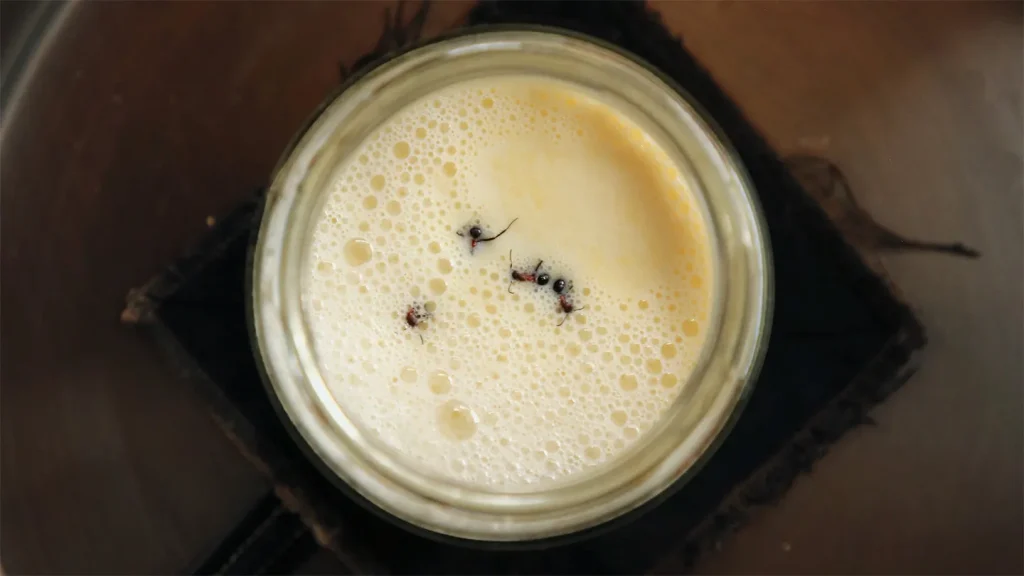The Ancient Art of Ant Yogurt: A Forgotten Culinary Tradition
In the verdant forests of Eurasia, a unique culinary tradition connects humans, insects, and microbes in an unexpected harmony. Red wood ants, those common forest dwellers we might typically avoid, have historically played a vital role in creating distinctively tangy yogurt in certain regional traditions. According to recent research published in iScience, these tiny creatures and their microbial companions help transform ordinary milk into creamy, fermented yogurt through a fascinating natural process. The study reveals something truly remarkable about our ancestors’ ingenuity – they discovered that living ants, rather than preserved ones, create the ideal biological environment for yogurt fermentation. This forgotten practice represents one of countless traditional food preparation methods that have been largely replaced by industrialization but continue to tell important stories about human cultural adaptation and our historical relationship with the natural world.
The yogurt-making tradition dates back approximately 7,000 years, emerging as humans domesticated animals and sought ways to preserve milk. While modern commercial yogurt production relies on carefully controlled bacterial cultures and standardized processes, traditional yogurt-making embraced a more diverse microbial world. Throughout history, communities developed unique starter cultures from their local environments – pinecones in some Turkish villages, chamomile flowers in others, and in certain Bulgarian mountain regions, the red wood ants of nearby forests. These varied approaches resulted in distinctive local flavors, creating culinary identities so specific that, as anthropologist Sevgi Mutlu Sirakova notes, villagers from her ancestral Bulgarian home could identify which household produced a yogurt simply by tasting it. This remarkable sensory knowledge speaks to the deep connection between food, identity, and place that industrial production, for all its safety benefits and consistency, cannot replicate.
The process of making ant yogurt combines simplicity with ecological wisdom. Researchers recreated the traditional method by placing four live red wood ants (Formica rufa or F. polyctena) into a jar of warmed raw cow’s milk. Rather than relying on electric yogurt makers or modern kitchen technology, practitioners would then bury this jar within an ant mound itself, using the natural heat generated by the colony as an incubator. After fermenting overnight in this living thermostat, the milk transformed – becoming acidic, developing a thicker consistency, and taking on complex tangy and herbaceous flavors distinctive to this method. This practice represents an intimate knowledge of the forest ecosystem, where humans recognized the unique properties of ant colonies and incorporated them into food production in a sustainable, renewable cycle.
The science behind this traditional practice reveals an intricate microbial dance. Molecular analysis showed that F. polyctena ants harbor beneficial bacteria that produce both lactic and acetic acids – the key compounds that transform and preserve milk. Among these, researchers identified Fructilactobacillus sanfranciscensis, a bacterial species also found in sourdough bread, highlighting the fascinating connections between seemingly unrelated fermentation traditions across cultures. Beyond their microbial contributions, the ants themselves add formic acid, a chemical they naturally produce as defense against predators, further enhancing the yogurt’s distinctive flavor profile. The process also involves milk-digesting enzymes from both the ants and bacteria, which work together to break down milk proteins and create the creamy, tangy final product. This complex biochemical interaction demonstrates how traditional practices often intuitively harness sophisticated biological processes without understanding their molecular mechanisms.
Interestingly, the researchers discovered that only living ants could properly facilitate this fermentation process. Attempts using frozen or dehydrated ants failed to produce the same results, as the preserved insects couldn’t contribute the same active microbial communities. This finding highlights the truly ecological nature of the practice – it required a direct, living connection between forest and food. However, this living connection also presents challenges for modern adoption. The research team cautions that live ants can potentially carry parasites that might, in rare cases, cause liver or gastrointestinal disease. As microbial ecologist Veronica Sinotte from the University of Copenhagen advises, this isn’t a DIY project the average person should attempt at home without proper knowledge. This tension between traditional practices and modern safety concerns reflects the broader challenges in preserving cultural food heritage while adhering to contemporary health standards.
The story of ant yogurt illuminates a fundamental aspect of human culinary history – our ancestors’ remarkable ability to observe and collaborate with the natural world to create nourishing foods. While industrial yogurt production has standardized flavors and ensured widespread safety and availability, something intangible has been lost in the transition. The unique microbial profiles of traditional yogurts created distinctive regional variations that connected people to their local environments and reinforced cultural identities. These practices weren’t simply about food preservation; they represented sophisticated ecological knowledge passed through generations. As we navigate a world increasingly concerned with food sustainability and biodiversity, these ancient practices offer valuable insights. They remind us that before refrigeration and global supply chains, humans developed ingenious solutions that worked in harmony with local ecosystems. The ant yogurt tradition stands as a testament to the deep culinary wisdom embedded in traditional food practices – wisdom that balanced nutrition, preservation, taste, and ecological harmony in ways we might do well to remember and respect, even as we embrace the benefits of modern food science.


